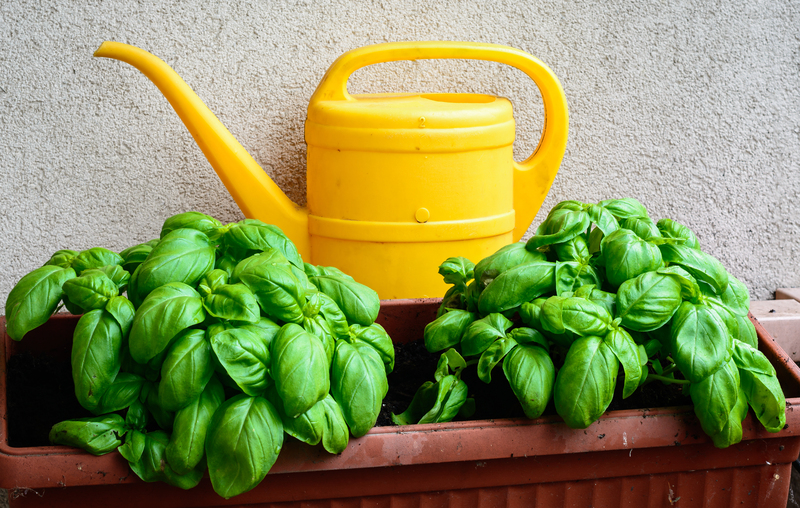Vertical Gardening: Merging Aesthetics with Ecology
Posted on 26/09/2025
Vertical Gardening: Merging Aesthetics with Ecology
Vertical gardening has taken root as a revolutionary solution in modern landscaping and eco-architecture, elegantly combining visual appeal with significant environmental benefits. This comprehensive guide will introduce you to the enchanting world of vertical gardens, their ecological impact, creative applications, and tips for designing your own sustainable green walls.
What Is Vertical Gardening?
Vertical gardening, also referred to as living walls or green walls, is the practice of growing plants upward on a vertically suspended structure. This approach maximizes space by utilizing walls and other vertical surfaces--making it ideal for urban environments, homes with limited outdoor areas, or anyone wishing to add a lush, green touch to buildings.
- Green Facades: Plants climb or hang from specially designed support systems.
- Living Walls: Pre-planted panels attached to structures containing growing mediums like soil or hydroponic substrates.
- Modular Systems: Self-contained pockets or containers mounted vertically, allowing easy rearrangement.

History of Vertical Gardens
The concept of vertical gardening isn't entirely new. Ancient cultures, such as the Babylonians, created the legendary Hanging Gardens, demonstrating humanity's long-standing desire to blend greenery into built environments. In recent decades, French botanist Patrick Blanc popularized modern vertical gardens, inspiring architects and city planners worldwide to integrate these lush installations into both public and private spaces.
Ecological Benefits of Vertical Gardening
Living walls and vertical ecosystems offer a range of ecological advantages. By merging aesthetics with ecology, they become far more than just decorative elements. Here are some ways they enhance environmental sustainability:
1. Improving Air Quality
- Absorbing Pollutants: Vertical gardens act as natural air filters, trapping dust, volatile organic compounds (VOCs), and other pollutants.
- Oxygen Production: Plants convert carbon dioxide into oxygen, refreshing indoor and outdoor environments alike.
- Humidity Regulation: Transpiring plants add needed moisture to dry city air, improving comfort and health.
2. Enhancing Biodiversity
Vertical plantings create habitats for insects, birds, and pollinators, boosting urban biodiversity. By adding a variety of native species to living green walls, gardeners can support local ecosystems, providing shelter and food for beneficial wildlife.
3. Urban Heat Island Mitigation
- Temperature Regulation: Green facades and living walls absorb sunlight, reducing the thermal load on buildings.
- Energy Savings: Insulating properties of vertical gardens help keep interiors cooler in summer and warmer in winter, leading to lower HVAC costs.
4. Stormwater Management
Vertical gardens help manage rainfall and runoff in densely built areas. Their soil and foliage systems absorb and filter water, lowering the risk of urban flooding and relieving pressure on drainage systems.
5. Sound Insulation
Dense plantings on vertical surfaces serve as effective sound barriers. By absorbing and deflecting urban noise, vertical gardens create more peaceful living and working environments.
Aesthetic Transformation Through Vertical Gardening
While the ecological benefits are substantial, vertical gardening's aesthetic impact is equally compelling. Living walls bring a sense of wellbeing and tranquility, introduce natural beauty, and transform sterile facades into vibrant spectacles.
Design Possibilities
- Patterned Plantings: Mix different textures and colors to craft striking designs or branded displays.
- Seasonal Interest: Rotate plant species throughout the year for continuous blooms and changing foliage.
- Mood Enhancement: Integrate aromatic herbs or calming greens to create soothing indoor environments.
- Edible Walls: Grow herbs, vegetables, and fruits vertically--merging beauty with culinary productivity.
Popular Plants for Vertical Gardens
Choosing the right plant species is vital for creating a thriving, low-maintenance vertical garden. Considerations include light, humidity, access to water, and maintenance requirements. Here are some excellent choices for various conditions:
Low-Light Indoor Plants
- Pothos (Epipremnum aureum)
- Philodendron
- Ferns (e.g., Boston Fern)
- Spider Plant (Chlorophytum comosum)
Sun-Loving Outdoor Plants
- Succulents (Sedum, Echeveria)
- Herbs (Thyme, Oregano, Basil)
- Flowering Vines (Clematis, Morning Glory)
- Grasses (Festuca)
How to Create a Vertical Garden: Step-by-Step
Setting up your own vertical garden combines creativity, practicality, and ecology. Follow these key steps to ensure a successful installation:
1. Select the Location
- Assess light exposure--south or east-facing walls often work best.
- Ensure structural support for the added weight of soil, water, and plants.
2. Choose a Vertical Garden System
- Modular Panels: Ideal for beginners due to modularity and scalability.
- Pocket Planting: Felt or fabric pockets allow for quick changes and easy irrigation.
- Trellis and Climbing Supports: Perfect for vining or trailing plants.
3. Irrigation and Drainage
Vertical gardens need efficient watering systems. Consider automatic drip irrigation for large walls, and ensure proper drainage to prevent root rot and facade damage.
4. Prepare the Growing Medium
- Hydroponic mediums (rock wool, perlite) for lightweight, soilless installations.
- Soil-based blends for richer nutrient supply and moisture retention.
5. Select and Arrange Plants
- Group plants by light and watering needs.
- Vary leaf textures and heights for visual interest.
- Include flowering or edible species for extra benefits.
6. Maintenance
- Regular pruning for plant health and aesthetic upkeep.
- Fertilize appropriately and monitor for pests or disease.
- Seasonally rotate or replace plants as needed.
Vertical Gardening in Urban Environments
Urban areas are prime candidates for vertical planting. As cities grapple with rising populations and shrinking green spaces, vertical landscaping strategies offer creative solutions to reconnect residents with nature, beautify public areas, and contribute to the fight against climate change.
Green Architecture and Building Integration
Forward-thinking architects now include integrated green walls on commercial and residential buildings. These structures:
- Reduce building heat absorption and lower cooling costs
- Create biophilic connections, supporting mental and physical wellness
- Demonstrate environmental responsibility and innovation
Vertical Gardens in Public Spaces
Urban vertical gardens make a striking impression in parks, transit stations, hotel lobbies, office exteriors, and shopping centers. They not only enhance property values but also foster community pride and well-being.
DIY Vertical Gardening Ideas
You don't need a professional installation or a towering budget to enjoy the benefits of vertical ecosystems. Here are some easy, creative ideas to start your own vertical planting project:
- Pallet Gardens: Upcycle wooden pallets to hold small pots or plant pockets, perfect for balconies and patios.
- Hanging Wall Planters: Fabric shoe organizers, recycled bottles, and pocketed wall hangings make fantastic mini gardens.
- Trellised Vegetable Walls: Grow climbers like beans, cucumbers, or tomatoes up sturdy trellises for edible vertical gardens.
- Living Art: Frame succulents or mosses as living picture installations indoors.
Common Challenges and Solutions
While vertical gardening is highly rewarding, it does come with unique challenges. Here's how to overcome the most common obstacles:
Watering and Drainage Issues
- Use automatic drip systems to deliver water evenly.
- Install trays or controlled drainage to prevent leaks and water damage.
Plant Selection Difficulties
- Choose species adapted to your regional climate and light levels.
- Start with hardy, low-maintenance varieties if you're a beginner.
Pest and Disease Management
- Regularly inspect for signs of infestation.
- Promote healthy air circulation and avoid overwatering.
- Opt for organic pest controls whenever possible.

The Future of Vertical Greenery
As sustainability becomes a global priority, architects, city planners, homeowners, and gardeners are embracing vertical gardens as essential components of urban ecology. Innovations in modular systems, hydroponics, and smart irrigation are making green walls more accessible, more efficient, and more spectacular than ever before.
The fusion of beauty and environmental stewardship offered by living walls will play an increasingly vital role in shaping the cities and homes of the future--providing cleaner air, cooler buildings, richer biodiversity, and serene spaces for people to work, live, and thrive.
Conclusion: Why Vertical Gardening Matters
In today's ever-expanding cities and digitally driven lifestyles, vertical gardening is a powerful way to reconnect with nature and promote sustainability. By merging aesthetic elegance with ecological function, every wall can become a thriving, living ecosystem. Whether you're looking for improved air quality, creative landscaping, or simply a lush backdrop to your home or workplace, vertical gardens offer a solution that is as beautiful as it is beneficial.
Start your own vertical garden journey today, and join a movement that is transforming our urban landscapes--one green wall at a time.

